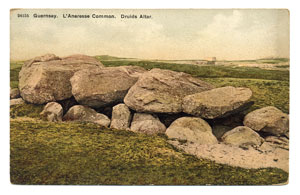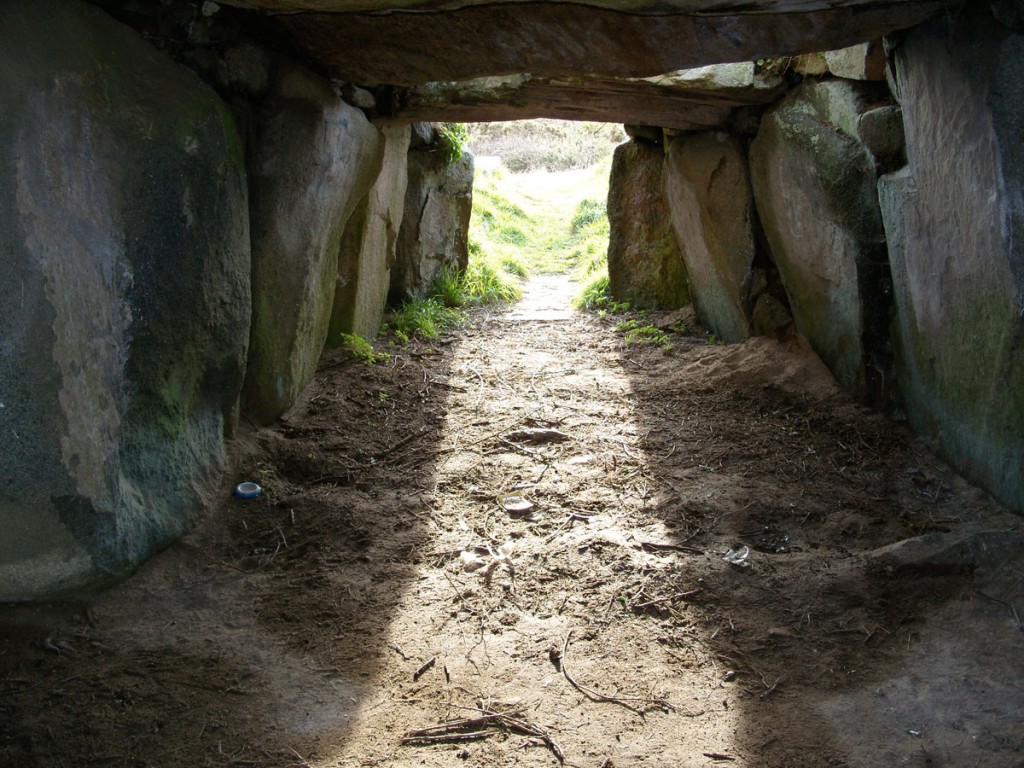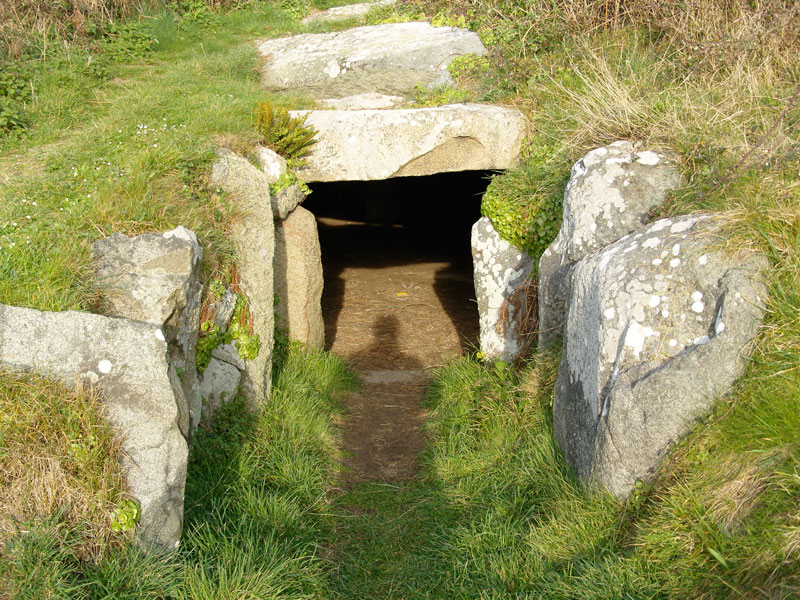La Varde can be found at the highest point of L’Ancresse common by the seventeenth green, not far to the north east of the modern menhir erected in 2000. Perry’s Guide Ref: 6 B2
La Rocque Qui Sonne may have been the largest monument if it had survived, but that dolmen didn’t have the fortune of being filled and buried with sand for many years like La Varde. This site was rediscovered in 1811 by soldiers who were stationed on this hill. While raising a rampart around their camp using the grass for turf, they exposed the capstones. Sir John Doyle, the Governor sent a party to excavate but for safety reasons stopped the exploration. During the summers of 1837-38 La Varde was thoroughly explored by the Lukis family. Full of sand, the grave revealed burials in at least two phases separated by a layer of limpet shells and pebbles. They also found many bones, some of children and some cremated remains in the lower of the two layers. Bones and skull fragments were found between the uprights and sherds from over 150 pottery jars were also unearthed.
Ferdinand Brock Tupper wrote in his 1854 History of Guernsey and its Bailiwick (p 392): “Cromlech at L’Ancresse – In the year 1811, a large cromlech was accidentally discovered, completely buried with drift sand, on an eminence near the beach at L’Ancresse, in Guernsey: it is 45 feet in length by 15 feet in width, and nearly 8 feet in height within the area at the western end, whence it gradually contracts on each side and at the top, near the eastern end. This space is covered by five larger and two smaller blocks of granite, which are not in contact: the western block is computed to weigh about thirty tons, it being nearly 17 feet long, 10 1⁄2 wide and 4 1⁄2 thick; and it was probably placed there by means of rollers. The second block is 16 feet long, the third smaller, and so they gradually diminish until the seventh. This fine cromlech was left filled and most imperfectly explored until the year 1837, when, after considerable labour, it was cleared of sand, and its primeval contents exposed, at the expense and through the antiquarian zeal of F. C. Lukis, Esq. before mentioned. On the floor were then found two layers consisting of human bones, urns of coarse red and black clay, stone and clay amulets and beads, bone pins, etc., the layers, like those of cists, being separated by flat fragments of granite: the lower stratum was laid in a rude pavement on the natural soil. The remains were deposited in a singular manner: the unburnt bones occupied either end of the floor, the middle third being allotted to those which had been submitted to the action of fire; not a vestige of charcoal was to be detected with them. The bones of individual skeletons were heaped together confusedly, and each heap surrounded by a ring of round flat pebbles; the urns, which were of remarkably rude shape and material, being near or within the rings. Some heaps consisted, as it were, of parent’s and children’s ashes mingled together, for within the same ring of pebbles were the bones of persons of all ages: an unusual quantity of bones of very young children were found. The lower stratum only contained the burnt bones, among which likewise a few tusks of the boar, perhaps worn as trophies of the chase, and consigned to the fire with the dead hunter’s body. Four flat discs, from six to twelve inches in diameter and one in thickness, formed the same ware as the urns, were also found, and doubtless served as lids to some of the urns, which had broad flat edges: as these lids are furnished with central handles, it may be inferred that the urns were replenished from time to time, the cromlech being a hollow vault or catacomb. In no instance was the urn used to contain the ashes of the dead, and it was doubtless filled with liquid or food – some were quite entire, and of those broken many had been restored. As time and ages elapsed, and, possibly, as all memory of the departed became lost, their remains were removed to make room for others; those so removed were placed in the interval between the props, and were lost to site; but further space being again required, many cart loads of limpet shells, and a little yellow clay, were strewn upon the original deposit; and flat stones, as already said, were placed over all to form a new floor.”
On one of my visits I took a compass. Passage graves Creux ès Fees, Le Trépied and Le Déhus (and La Rocque Qui Sonne) are pretty much aligned east-west which makes reasonable sense as this is the line of the sun’s rising and setting – not difficult to understand how and why.
La Varde does not do this and points east-south east. Standing on the first capstone and standing right at the back of the dolmen, it is very clear to see that the passage to this grave is aligned to Rocque Balan. On the day of the Spring Equinox light streams in as shown in the picture above. If you think this is just a coincidence then see the picture below that shows my shadow and the alignment.




Pingback: 'Sketching on Guernsey' - Nick Watton ~ artist
Pingback: Guernsey Travel Guide - Things to do, visiting Guernsey in the Channel Islands - Travelingforme
Pingback: Guernsey Travel Guide - Things to do, visiting Guernsey in the Channel Islands - Kavodtravel